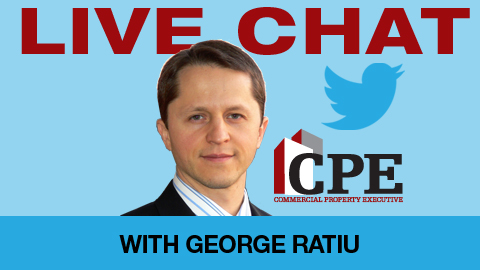Twitter Chat: George Ratiu on Market Fundamentals, Economic Outlook for 2013
NAR economist George Ratiu chats with CPE editors live via Twitter about latest economic trends and forecasts for the commercial real estate industry.
National Association of Realtors economist George Ratiu took time out of his busy schedule to chat with  Commercial Property Executive editors live via Twitter, in 140 characters or less per tweet, lending his expertise and take on the latest economic trends, the effects on the real estate industry and his predictions for the coming months and years. Below is the transcript of the exchange.
Commercial Property Executive editors live via Twitter, in 140 characters or less per tweet, lending his expertise and take on the latest economic trends, the effects on the real estate industry and his predictions for the coming months and years. Below is the transcript of the exchange.
CPE: George, what is your assessment of market fundamentals at the midpoint of the year?
Ratiu: Market fundmantals do reflect the broader macroeconomic peformance. We have an economy with a real GDP value of $13.3 trillion, higher than the prior peak in 2007. The first quarter GDP annual growth rate was 1.8 percent, slightly weaker than initially estimated. Consumer spending — which makes up 70 percent of the economy — grew at 2.6 percent, a much stronger rate than the previous quarters. These are reflected in the fundamentals: Demand remains positive but not strong, vacancies are declining at a slower pace. Office markets are flat, with relatively high vacancies. The industrial sector has benefited from international trade. Retail has seen declines in vacancies and growing rents. And apartments are showing vacancy compressions.
CPE: What about the pace of CRE investment sales?
Ratiu: The pace is advancing at a good clip. Sales of major properties were up 24 percent in the first half of 2013, totaling $145.3 billion. There is strong investor demand for quality assets, stability of principal and return. We still see a bifurcation of investment sales along property values. The high end has been advancing and doing well. At the lower end (<$2 million), sales recovery has been slower, hampered by availability of capital and financing options.
CPE: How is capital availability impacting CRE at the midyear point?
Ratiu: Capital availability is rising and the landscape of available capital has been diversifying. National banks have become more active, along with institutional investors and insurance companies. These players almost disappeared from the market in the 2009-11 period. In the top markets, they are competing for deals, providing plenty of capital for CRE. In secondary/tertiary markets, the picture is more nuanced. Local/regional banks and private investors provide the bulk of financing, and the underwriting standards remain tight.
CPE: What is the role of CMBS today?
Ratiu: It is especially noticeable in secondary/tertiary markets. CMBS issuance has rebounded from its crash in ’08-’09. New CMBS rose 48 percent year over year in 2012, and is expected to repeat that performance this year. While it will not reach the dominant market position anytime soon (40+ percent in ’07), it will add to capital liquidity.
CPE: What is the impact of the Fed’s likely tapering of QE upon CRE?
Ratiu: In short, it will raise the cost of capital and put pressure on yields. However with current spreads at almost 500 basis points across property types, there will be room enough to adjust. The short-term impact should be minimal. For example, insurance companies are offering loans 10-year fixed with LTV of 65 percent at 3 to 4 percent. With second-quarter average cap rates at 6.98 percent for office properties and T-bills at 1.9 percent, an investor is still looking at a positive return.
CPE: Going back to office performance, when do you see vacancies improving?
Ratiu: Vacancies were flat in Q2 and remain elevated, in large part due to modest office-using job growth. Until job growth regains the lost ground of 2008-09, demand for office space is likely to remain soft. In Q2, markets with the strongest office rent growth were in tech/energy centers: San Jose, San Francisco, New York City, Seattle and Houston.
CPE: Finally, what is the economic outlook for the remainder of 2013 and into 2014?
Ratiu: We expect GDP to grow by 1.8 percent in 2013 and 2.7 percent in 2014, with employment at about two million new jobs this year. With higher taxes, sequestration and coming costs of the new Healthcare Act, economic growth will remain tepid but positive.
CPE: Thank you for the very informative chat, George!
Ratiu: Thank you, as well! I certainly enjoyed it and hope your readers and followers found it informational.
For the live Twitter Chat, go to https://twitter.com #cpechat.







You must be logged in to post a comment.